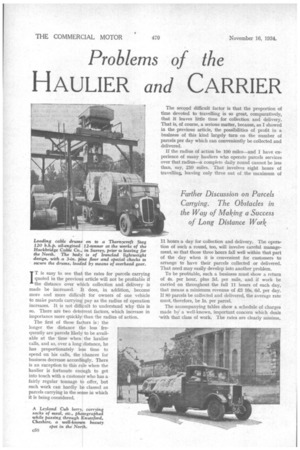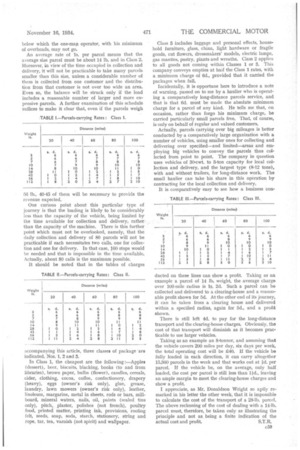Problems of the
Page 124

Page 125

If you've noticed an error in this article please click here to report it so we can fix it.
HAULIER and CARRIER IT is easy to see tha1 the rates for parcels carrying quoted in the previo article will not be profitable if the distance over w ich collection and delivery is made be increased, does, in addition, become more and more difficu t for owners of one vehicle
to make parcels carryin pay as the radius of operation increases. It is not d ii nit to understand why this is so. There are two dete ent factors, which increase in importance more quickly than the radius of action.
The first of these fa tors is : the
longer the distance e less frequently are parcels likel to be avail
able at the time when the haulier calls, and as, over a long distance, he has proportionately le s time to spend on his calls, the hances for business decrease accord' gly. There is an exception to this le when the haulier is fortunate en ugh to get into touch with a custom r who has a fairly regular tonnage t offer, but such work can hardly b classed as parcels carrying in the as se in which it is being considered. The second difficult factor is that the proportion of time devoted to travelling is so great, comparatively, that it leaves little time for collection and delivery. That is, of course, a serious matter, because, as I showed in the previous article, the possibilities of profit in a business of this kind largely turn on the number of parcels per day which can conveniently be collected and delivered.
If the radius of action be 100 miles—and I have experience of many hauliers who operate parcels services over that radius—a complete daily round cannot be less than, say, 210 miles. That involves eight hours of travelling. leaving only three out of the maximum of 11 hours a day for collection and delivery. The operation of such a round, too, will involve careful management, so that those three hours fall well within that part of the day when it is convenient for customers to arrange to have their parcels collected or delivered. That need may easily develop into another problem.
To be profitable, such a business must show a return of 4s. per hour, plus 3d. per mile, and if work be carried on throughout the full 11 hours of each day, that means a minimum revenue of £3 16s. 6d. per day. If 80 parcels be collected and delivered, the average rate must, therefore, be Is. per parcel.
The accompanying tables show a schedule of charges made by a well-known, important concern which deals 'with that class of work. The rates are clearly minima, below which the one-man operator, with his minimum of overheads, may not go.
An average rate of is. per parcel means that the average size parcel must be about 14 lb. and in Class 2. Moreover, in view of the time occupied in collection and delivery, it will not be practicable to take many parcels smaller than this size, unless a considerable number of them is collected from one customer and the distribution from that customer is not over too wide an area. Even so, the balance will be struck only if the load includes a reasonable number of larger and more expensive parcels. A further examination of this schedule suffices to make it clear that, even if the parcels weigh
56 lb., 40-45 of them will be necessary to provide the revenue expected.
One curious point about this particular type of journey is that the loading is likely to be considerably less than the capacity of the vehicle, being limited by the time available for collection and delivery, rather than the capacity of the machine. There is this further point which must not be overlooked, namely, that the daily collection and delivery of 80 parcels will not be practicable if each necessitates two calls, one for collection and one for delivery. In that case, 160 stops would he needed and that is impossible in the time available. Actually, about 80 calls is the maximum possible.
It should be noted that in the tables of charges accompanying this article, three classes of package are indicated, Nos. 1, 2 and 3.
In Class 1, the cheapest are the following :—Apples (dessert), beer, biscuits, blacking, books (to and from libraries), brown paper, bulbs (flower), candles, cereals, cider, clothing, cocoa, coffee, confectionery, drapery (heavy), eggs (owner's risk only), glue, grease, laundry, lawn mowers (owner's risk only), leather, linoleum, margarine, metal in sheets, rods or bars, millboard, mineral waters, nails, oil, paints (sealed tins only), pitch, plaster, polishes (not french), poultry food, printed matter, printing ink, provisions, roofing felt, seeds, soap, soda, starch, stationery, string and rope, tar, tea, varnish (not spirit) and wallpaper. Class 3 includes luggage and personal effects, household furniture, glass, china, light hardware or fragile goods, cut flowers, dressmakers' models,electric lamps, gas mantles, pastry, plants and wreaths. Class 2 applies to all goods not coming within Classes 1 or 3. This company conveys empties at half the Class 1 rates, with a minimum charge of 6d., provided that it carried the packages when full.
Incidentally, it is opportune here to introduce a note of warning, passed on to me by a haulier who is operating a comparatively long-distance parcels service, and that is that 6d. must be made the absolute minimum charge for a parcel of any kind. He tells me that, on occasion, rather than forgo his minimum charge, be carried particularly small parcels free. That, of course, is only on behalf of regular and valued customers.
Actually, parcels carrying over big mileages is better conducted by a comparatively large organization with a number of vehicles, using smaller ones for collecting and delivering over specified—and limited—areas and employing big vehicles to convey the parcels thus collected from point to point. The company in question uses vehicles of 30-cwt. to 3-ton capacity for local collection and delivery, and the largest type (8-12 tons), with and without trailers, for long-distance work. The small haulier can take his share in this operation by contracting for the local collection and delivery.
It is comparatively easy to see how a business con ducted on these lines can show a profit Taking as an example a parcel of 14 lb. weight, the average charge over 100-mile radius is is. 2d. Such a parcel can be collected and delivered to a clearing-house and a reasonable profit shown for 5d. At the other end of its journey, it can be taken from a clearing house and delivered within a specified radius, again for 5d., and a profit shown.
There is still left 4d. to pay for the long-distance transport and the clearing-house charges. Obviously, the cost of that transport will diminish as it becomes practicable to use larger vehicles.
Taking as an example an 8-tonner, and assuming that the vehicle covers 200 miles per day, six days per week, the total operating cost will be E40. If the vehicle be fully loaded in each direction, it can carry altogether 15,360 parcels in the week and that works out at Id. per parcel. If the vehicle be, on the average, only half loaded, the cost per parcel is still less than lid., leaving an ample margin to meet the clearing-house charges and show a profit I appreciate, as Mr. Donaldson Wright so aptly re marked in his letter the other week, that it is impossible to calculate the cost of the 'transport of a 28-lb. parcel. The above reckoning of the cost of dealing with a 144b. parcel must, therefore, be taken only as illustrating the principle and not as being a finite indication of the actual cost and profit




















































































































































































